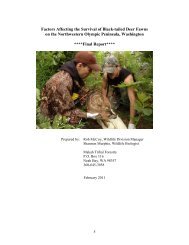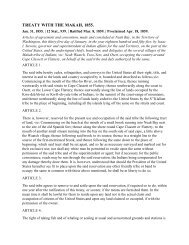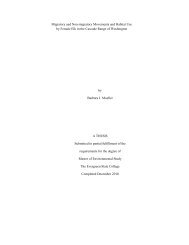Spring - NWIFC Access - Northwest Indian Fisheries Commission
Spring - NWIFC Access - Northwest Indian Fisheries Commission
Spring - NWIFC Access - Northwest Indian Fisheries Commission
- No tags were found...
You also want an ePaper? Increase the reach of your titles
YUMPU automatically turns print PDFs into web optimized ePapers that Google loves.
Smolt Trap Gathers Fish, InformationAs daylight fades over Monroe, a crew gracefully positionsa contraption over the Skykomish River’s fish run.Once the metal trap has reached the middle of the river, itwill begin collecting salmon smolts from the water – andgathering data invaluable to salmon recovery efforts.The Tulalip Tribes are undertaking the first comprehensivestudy of this type on the Skykomish River. BeginningApril 4, scientists and technicians began capturing and releasingmigratory fish – all to learn more about the uniquelife process and population size of the chinook salmon.“It’s been successful in other places,” said Kurt Nelson,fish and water wildlife resources scientist with the TulalipTribes, “but nobody has tried this means to assess populationsize on the Skykomish before.”The equipment the tribal team uses – called a ‘screw trap’– allows technicians to monitor fish without injuring them.Fish are drawn in through the trap’s wide ‘cone,’ which isdesigned to safely capture the young salmon, and are funneledinto an holding area. There, the juvenile salmon andtrout will be counted, measured and set free.The design of the trap, which was fine-tuned by Lumminatural resources biologist Mike MacKay, is spreading. Onthe lower portion of the Nooksack River, Lummi teams haveoperated a trap since 1994. A crew from the Nooksack Tribecurrently operates one on the south fork of the NooksackRiver. The Stillaguamish Tribe is going through the permittingprocess for a smolt trap of its own as well.The research efforts have similar aims: to examine howmany fish are traveling to the sea, how successful their migrationsare, and the means the salmon use to survive.“This is going to give us quite a bit of information onpopulation size, behavior, migratory patterns, freshwatersurvival, and what kind of life cycle variations exist amongchinook,” Nelson said.From left, Kurt Nelson, Miriam Bill and Gene Enick monitorthe Tulalip Tribes’ smolt trap on the Skykomish River nearMonroe. Photo: J. ShawHarvest managers rely on that kind of data to forecast thesizes of fish runs. It should also prove useful to habitat managerswho are working on a recovery plan for the Skykomishwatershed.This research effort is focused on the river’s chinook run,but will also provide information on coho, chum, sockeye,and pink salmon, as well as cutthroat, steelhead, brown bulland Dolly Varden trout.The Tulalip project is a cooperative effort with SnohomishCounty, and is fully funded over the next two years – throughan Environmental Protection Agency grant during 2000 anda Bureau of <strong>Indian</strong> Affairs grant during 2001. The TulalipTribes are planning to undertake a similar research projecton the Snoqualmie River next year. – J. Shaw<strong>Northwest</strong> <strong>Indian</strong> <strong>Fisheries</strong> <strong>Commission</strong>6730 Martin Way EastOlympia, WA 98506(360) 438-1180BULK RATEU.S. POSTAGEPAIDMAIL NW









